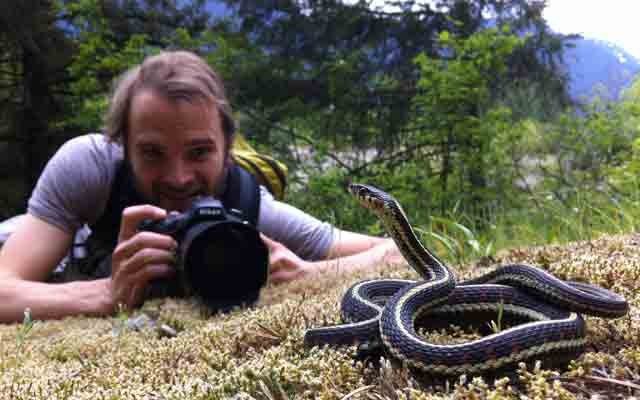On a sunny August day a few years back, at the start of a canoe trip through Ontario's Algonquin Park with my then 16-year-old daughter, Myles, we pulled into a portage at the head of a small lake. A few metres from shore, where a scatter of sandy footprints merged into a grass-limned trail, several Eastern Gartersnakes had woven themselves into a neat pile. It was too early in the year for the species' fall denning aggregations, and too late for its springtime "mating balls" (where a mob of dozens of males zero in on the pheromones of a single female), so I guessed it to be a "parturition party" — where pregnant females gather together to bask. Like most reptiles at northern latitudes, gartersnakes bear live young instead of laying heat-demanding eggs, and females often engage in this little-known trick of thermoregulation that allows the group to collectively raise their individual body temperatures and metabolisms, advancing embryonic development and, hence, the birthing process. Myles, of course, was full of questions: Why here? Why just pregnant ones?
Well... I suppose you can see similar synods on a Starbucks patio, but I wasn't about to erect that analogy. Despite its dry detail, Myles listened to my explanation attentively and with apparent interest. As a city-dwelling, pop-culture-addled teenager about to slip from the parent-worship grasp of childhood, I considered this a good omen for some quality bonding on our trip. Grubbing through forest and ponds with me is something Myles had done often, be it tagging along on journalistic assignments or adventuring together at various Ontario cottages. As proof, I have a library of photos in which a young girl at various ages displays in her hands a litany of frogs, salamanders, snakes and turtles. In early shots she always seems torn between scrutinizing the creature and smiling at the camera, a mixture of fascination and the childish aim to please; as the catalogue advances, she cradles the startled, bug-eyed critters with more concern, reflecting a growing passion for animals and appreciation of their fragility. In recent poses, however, I'd detected a noticeable tentativeness. Was it adolescent self-consciousness and the accompanying meme-ish female allergy to rot and ick and traumatized fingernails? Or just momentary uncertainty borne of the decreasing frequency of these opportunities?
Whichever the case, I felt it was something passing, and that the scene at the portage had rekindled our rolling Chautauqua of the animal netherworld. I also realized how happy I was to answer her questions. (Though she'd later stump me: "If you drop a frog in the middle of a lake, does it know which way to swim?") This process of interpretation had, in no small measure, become part of my own enjoyment of nature.
For the same reason, this past April, I was excited to take celebrated North Vancouver photographer Jordan Manley out to photograph reptiles in Pemberton. He'd taken to shooting wildlife in the past few years, seen the serpentine Instagrams I'd posted, and was eager to train his considerably more sophisticated lens on these fascinating, seldom-seen creatures. It was perfect weather for reptiles — warm and hazy — and within minutes I'd caught a Wandering Gartersnake, giving Jordan a close-up look at its brown-and-black checkerboard dorsal pattern. Using what Jordan labelled my "reptile radar," I found several other local species — Valley Gartersnake, Rubber Boa, Sharp-tail Snake and Alligator Lizard — heartened to help someone glimpse creatures they would otherwise never see. Jordan's interest (he had as many questions as Myles) was particularly welcome because of something I've encountered since moving to Whistler: Many folks I know, despite being dedicated outdoorists (often far more so than me) can point to an old growth forest but barely differentiate its trees; will profess spiritual affinity to charismatic megafauna like whales and bears and eagles but be unable to identify any creature smaller than a coyote; will happily ride mountain bikes in "awesome" places without being able to grok the ecosystem passing under their wheels. Though most of us are liberated city dwellers who've taken to the mountains, it turns out that many seem to embrace them as playgrounds first and raw nature only as afterthought. Could it be a lingering symptom of Nature Deficit Disorder (NDD)?
Advanced as a clinical hypothesis by Richard Louv in Last Child in the Woods (2005), NDD holds that humans, especially children, are spending less time outdoors, resulting in a wide range of problems. Louv points to many things: how parents' growing fear of the world keeps children inside on the computer rather than outdoors exploring; the loss of natural surroundings in city neighborhoods; parks and preserves with restricted access and "do not walk off trail" signs; educators and environmentalists who tell kids to "look don't touch." The upshot, as Louv writes, are children with limited respect for natural surroundings: "An increasing pace... of a rapid disengagement between children and direct experiences in nature... has profound implications, not only for the health of future generations but for the health of the Earth itself."
Since we are nature as well, connection is key. If people are suffering less engagement with nature, then it can only be good to share as much as you can, whenever you can. And that's not just my post-hoc rationalization for geeking out on creepy crawlies wherever and whenever I'm asked: I'm actually providing a concierge service. The best thing about nature is that it doesn't need to be created or cajoled into awesomeness. When you take someone out for a walk in the woods you only need to bring wonder, knowledge and the willingness to turn over a few rocks — the rest is already out there.
(The eighth annual Whistler BioBlitz is planned for August 23-24 — a great place to learn about the nature around us. See www.whistlernaturalists.ca for more information.)
Leslie Anthony is a Whistler-based author, editor, biologist and bon vivant who has never met a mountain he didn't like.




